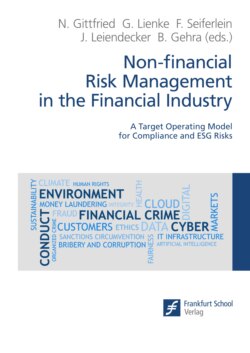Читать книгу Non-financial Risk Management in the Financial Industry - Группа авторов - Страница 5
На сайте Литреса книга снята с продажи.
Foreword
ОглавлениеThese are turbulent times for the financial industry and for society at large. Banks, insurers, asset managers and other financial services providers are subject to a profound, lasting disruption, shaping the way value is created and how people will work in the decades to come.
Climate change and the role of the financial industry in the historical transformation toward greenhouse-gas neutrality is at the top of almost every CEO’s agenda. The industry is subject to game-changing environment, social and governance regulation (ESG) and disclosure requirements and is adopting a role as a change agent to finance the climate transition. The climate agenda deeply impacts the industry’s business and risk strategies, triggering fundamental changes to the way financial and non-financial risks are managed.
Since the COVID-19 outbreak in late 2019, society has seen a whirl of lockdowns and contact restrictions. The pandemic has also impacted businesses of all shapes and sizes across a range of industries, with the 2020 global gross domestic product down almost by 3.5%.[1] The financial industry has continued to prove its social and economic relevance during the pandemic, delivering vital aid to businesses and individuals at record speed, creating new processes and systems on the fly and shifting workforces and operations to remote conditions. COVID-19 accelerated digitisation to new heights, with some senior executives painfully realising that digital is not optional but a question of making the cut.
On top, regulatory agencies are ramping up their efforts to ensure corporations obey the rules – and imposing heavy penalties on those that fail to deliver. From 2009 to 2020, global regulators handed out almost 400 billion in fines for non-compliance.[2]
To emerge stronger from these challenging times, financial institutions must succeed on many fronts, with non-financial risk management being a critical component. This holds particularly true in times of geopolitical unrest such as the conflict between Russia and the Ukraine right now. For global financial organisations with a broad product portfolio across multiple geographical regions, the management of non-financial risks is complex, and pitfalls are looming: insufficient consistency in policy standards, a divergence in the regional execution, opaque risk exposure and a fragmented IT landscape, to name just a few. The need for a bank-wide, global non-financial risk management framework has become abundantly clear.
This handbook is intended as a guide to establish a target operating model for non-financial risk management, primarily for the financial industry, and covers the entire risk management lifecycle. This includes a definition of non-financial risk, risk appetite frameworks, risk governance, top-down non-financial risk assessments, internal control frameworks, data and IT governance as well as conduct and ethics.
The editors are grateful to the contributors, who are all leading experts in non-financial risk management, compliance and ESG.
Frankfurt and Munich, February 2022
The editors Norbert Gittfried, Dr. Georg Lienke, Florian Seiferlein, Jannik Leiendecker and Dr. Bernhard Gehra
Fußnoten:
[1] IMF 2021.
[2] BCG 2021a.
